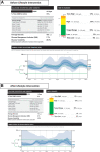Beyond A1C-Standardization of Continuous Glucose Monitoring Reporting: Why It Is Needed and How It Continues to Evolve
- PMID: 34149250
- PMCID: PMC8178725
- DOI: 10.2337/ds20-0090
Beyond A1C-Standardization of Continuous Glucose Monitoring Reporting: Why It Is Needed and How It Continues to Evolve
Abstract
Continuous glucose monitoring (CGM) systems are becoming part of standard care for type 1 diabetes, and their use is increasing for type 2 diabetes. Consensus has been reached on standardized metrics for reporting CGM data, with time in range of 70-180 mg/dL and time below 54 mg/dL recognized as the key metrics of focus for diabetes management. The ambulatory glucose profile report has emerged as the standard for visualization of CGM data and will continue to evolve to incorporate other elements such as insulin, food, and exercise data to support glycemic management.
© 2021 by the American Diabetes Association.
Figures


References
-
- Riddlesworth TD, Beck RW, Gal RL, et al. . Optimal sampling duration for continuous glucose monitoring to determine long-term glycemic control. Diabetes Technol Ther 2018;20:314–316 - PubMed
-
- Šoupal J, Petruželková L, Grunberger G, et al. . Glycemic outcomes in adults with T1D are impacted more by continuous glucose monitoring than by insulin delivery method: 3 years of follow-up from the COMISAIR study. Diabetes Care 2020;43:37–43 - PubMed
-
- Agiostratidou G, Anhalt H, Ball D, et al. . Standardizing clinically meaningful outcome measures beyond HbA1c for type 1 diabetes: a consensus report of the American Association of Clinical Endocrinologists, the American Association of Diabetes Educators, the American Diabetes Association, the Endocrine Society, JDRF International, the Leona M. and Harry B. Helmsley Charitable Trust, the Pediatric Endocrine Society, and the T1D Exchange. Diabetes Care 2017;40:1622–1630 - PMC - PubMed
-
- Beyond A1C Writing Group . Need for regulatory change to incorporate beyond A1C glycemic metrics. Diabetes Care 2018;41:e92–e94 - PubMed

